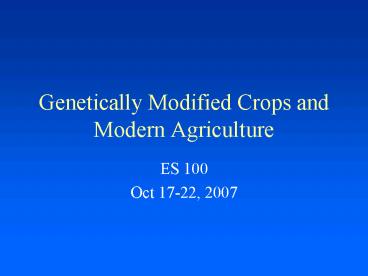Genetically Modified Crops and Modern Agriculture - PowerPoint PPT Presentation
1 / 20
Title:
Genetically Modified Crops and Modern Agriculture
Description:
Variety in genetic structure enhances viability against ... Oats Alamo-X x-rays. Grapefruit Rio Red thermal neutrons. Grapefruit Star Ruby thermal neutrons ... – PowerPoint PPT presentation
Number of Views:866
Avg rating:3.0/5.0
Title: Genetically Modified Crops and Modern Agriculture
1
Genetically Modified Crops and Modern Agriculture
- ES 100
- Oct 17-22, 2007
2
Genetically Modified Crops
- Cross-breeding to strengthen traits
- Variety in genetic structure enhances viability
against disease, pests, climate variability
Assyrian relief carving pollinating palms, 870 BC
3
Current Use of Transgenic Varietals
- US is by far leader of use of GMC
4
Worldwide Acreage of GM Crops
- Crop 1999 (millions of acres)
- Soybean 53.4
- Corn 27.4
- Cotton 9.1
- Canola 8.4
- Potato 0.3
- Squash 0.3
- Papaya 0.3
- Source Science (1999) 2861663.
5
Worldwide Acreage of GM Crops
6
Induced genetic mutations pre-transgenic
- Crop Cultivar Name Method to Induce
Mutation - Rice Calrose gamma rays
- Wheat Above sodium azide
- Wheat Lewis thermal neutrons
- Oats Alamo-X x-rays
- Grapefruit Rio Red thermal neutrons
- Grapefruit Star Ruby thermal neutrons
- Bermuda grass Tif gamma rays
- Lettuce Ice Cube ethyl methanesulphonate
- Lettuce Mini-Green ethyl methanesulphonate
- Green Bean Seafarer x-rays
- Green Bean Seaway x-ray
- Lilac Prairie Petite gamma rays
- Also begonia, carnation, chysanthemum, dahlia,
snapdragons
7
Creating transgenic varietals
- Gene transfer from host (bacteria, other plant
species, animal species) - Host tissue cultured
- Plant transferred to field
Transfer gene into plant culture plant
grow.
8
Corn
Corn rootworm and GM resistance
Bt-corn hybrid and original varietal with Corn
Borer
9
Cotton
Cotton bollworm and Bt-resistant cotton
10
Soybeans
Soybeans with weeds, no pesticide application
Roundup-Ready Soybeans after pesticide application
11
Improved Nutritional Content
Canola enhanced with vitamin E
Golden rice with enhanced beta-carotene
(pre-vitamin A)
Tomatoes enhanced with greater lycopene and
vitamins
12
Concerns about GMCs
Transgenic insecticidal corn genes believed to
transfer to milkweeds and harm Monarchs
Transgenic canola fields cross-pollinated with
other fields spreading cultivar beyond
anticipated region
13
Refuge Strategy to Reduce Resistance
14
Acreage of GM Crops by Trait
- Trait 1999 (millions acres)
- Herbicide tolerance 69.4
- Bt insect resistance 22.0
- Bt herbicide tolerance 7.2
- Virus resistance 0.3
- Source Science (1999) 2861663.
15
Implications of GMC Use in Agriculture
- Some have been designed to increase use of
high-input crops (others to decrease reliance on
these inputs) - Encourages monocropping
- Facilitates pathogen and pest resistance
- No long-term studies on maintained productivity
- Builds need for continued bio-tech development of
future strains
GMC and non-GMC tomato plants
16
Agribusiness
17
Rice wild rice strains
Cal-rose GM rice
18
Preserving crop diversity
Uncultivated wheat
Anasazi seeds re-grown and preserved
Desert mesclan beans
Seed bank in Cali, Columbia
19
Labeling and Bovine Growth Hormones
- 38 PA polled in 1996 stated that they would not
drink milk with rBGH - 81 PA supported labeling
- FDA determined that labeling not required
The Weiss Farm uses no rBGH and wants their
consumers to know it
20
Uses and Claims of rBGH
- Natural or synthetic sex hormones
administered to animals to improve ability to use
nutrients more efficiently - Improve meat quality (more lean meat, decreased
fat content) - Increase dairy production
- Increase feed efficiency allowing more growth
with less feed - Reduce costs for producers (and theoretically for
consumers)
Large-scale cattle feedlot































